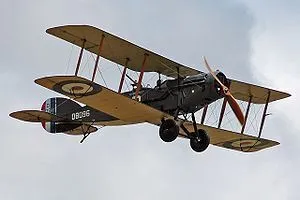F.2 (Bristol) (Total: 2,456, Canadian: 31, Group 0)
Bristol F.2 (Bristol)

The Shuttleworth Collection's Bristol F.2B Fighter
The Bristol F.2 Fighter was a British two-seat biplane fighter and reconnaissance aircraft of the First World War developed by Frank Barnwell at the Bristol Aeroplane Company. It is often simply called the Bristol Fighter, other popular names include the "Brisfit" or "Biff".
Although the type was intended initially as a replacement for the pre-war Royal Aircraft Factory B.E.2c reconnaissance aircraft, the new Rolls-Royce Falcon V12 engine gave it the performance of a two-seat fighter.
Despite a disastrous start to its career, the definitive F.2B version proved to be a manoeuvrable aircraft that was able to hold its own against single-seat fighters; its robust design ensured that it remained in military service into the 1930s. Some surplus aircraft were registered for civilian use and civilian versions proved popular.
Perhaps one of the best known flying aces to use the type was Canadian Andrew Edward McKeever, and his regular observer L.F. Powell.[18] By the end of 1917 McKeever had accumulated 30 shoot-downs of enemy aircraft, while Powell had achieved eight aerial kills, while operating the Fighter. McKeever later became a flying instructor stationed in England before becoming the commanding officer of No. 1 Squadron of the newly formed Royal Canadian Air Force (RCAF), where he continued to use the Fighter as his personal aircraft, which was later transferred to Canada Wikipedia
F.2 (Bristol) F.2A serial A3311
s/n A3311
A 3311
Known Units:
last update: 2025-December-26
F.2 (Bristol) F.2B serial B1211
s/n B1211
c/n 2378
B 1211
Known Units:
last update: 2025-December-26
F.2 (Bristol) F.2B serial B1238
s/n B1238
c/n 2405
B 1238
Known Units:
last update: 2025-December-26
F.2 (Bristol) F.2B serial B1322
s/n B1322
c/n 2489
B 1322
F.2 (Bristol) F.2B serial B1341
s/n B1341
c/n 2508
B 1341
Known Units: ;88
last update: 2025-December-26
F.2 (Bristol) F.2B serial C791
s/n C791
C 791
Known Units: ;48
last update: 2025-December-26
F.2 (Bristol) F.2B serial C839
s/n C839
C 839
Known Units: ;88
last update: 2025-December-26
F.2 (Bristol) F.2B serial C850
s/n C850
C 850
Known Units: ;20
last update: 2025-December-26
F.2 (Bristol) F.2B serial C871
s/n C871
C 871
Known Units: ;46th
last update: 2025-December-26
F.2 (Bristol) F.2B serial C887
s/n C887
C 887
Known Units:
last update: 2025-December-26
F.2 (Bristol) F.2B serial C889
s/n C889
C 889
Known Units:
last update: 2025-December-26
F.2 (Bristol) F.2B serial C894
s/n C894
C 894
Known Units:
last update: 2025-December-26
F.2 (Bristol) F.2B serial C935
s/n C935
C 935
Known Units: ;48
last update: 2025-December-26
F.2 (Bristol) F.2B serial C980
s/n C980
C 980
Known Units: ;20
last update: 2025-December-26
F.2 (Bristol) F.2B serial C1000
s/n C1000
C 1000
Known Units: ;88
last update: 2025-December-26
F.2 (Bristol) F.2B serial C4604
s/n C4604
C 4604
Known Units:
last update: 2025-December-26
F.2 (Bristol) F.2b serial C4808
s/n C4808
C 4808
Known Units: 22
last update: 2025-December-26
F.2 (Bristol) F.2B serial C4810
s/n C4810
C 4810
Known Units:
last update: 2025-December-26
F.2 (Bristol) F.2B serial C4815
s/n C4815
C 4815
Known Units: 39
last update: 2025-December-26
F.2 (Bristol) F.2B serial C4830
s/n C4830
C 4830
Known Units:
last update: 2025-December-26
F.2 (Bristol) F.2B serial C4844
s/n C4844
C 4844
Known Units:
last update: 2025-December-26
F.2 (Bristol) F.2B serial C4862
s/n C4862
C 4862
Known Units:
last update: 2025-December-26
F.2 (Bristol) F.2B serial C4866
s/n C4866
C 4866
Known Units:
last update: 2025-December-26
F.2 (Bristol) F.2B serial C4887
s/n C4887
C 4887
Known Units:
last update: 2025-December-26
F.2 (Bristol) serial E2158
s/n E2158
E 2158
Known Units:
last update: 2025-December-26
F.2 (Bristol) serial E2458
s/n E2458
E 2458
Known Units:
last update: 2025-December-26
F.2 (Bristol) serial E2470
s/n E2470
E 2470
Known Units:
last update: 2025-December-26
F.2 (Bristol) serial E2509
s/n E2509
E 2509
Known Units:
last update: 2025-December-26
F.2 (Bristol) serial E2590
s/n E2590
E 2590
Known Units:
last update: 2025-December-26
F.2 (Bristol) F.2B serial G-CYBC
s/n GCYBC
G-CYBC
Known Units:
Ex RAF F4336. Was operated in UK by No. 1 Squadron, CAF, before being shipped to Canada in 1920. Operated from Ottawa, Ontario summer of 1920. Hard landing by Squadron Leader J. H. Tudhope, damaged fuselage, at Mountain Grove, Ontario, May 1921. Floats were ordered for this aircraft, no record of installation. Used for testing of survey cameras, including the RAF style LB (Mk. I) camera, from Rockcliffe, Ontario in summer of 1921. Found unsuitable for survey work, because of pilot workload in maintaining straight and level flight, and poor communications between pilot and camera operator.last update: 2025-November-19
1920-August-06 Taken on Strength 2022-02-07
1922-February-07 Struck off Strength 2019-08-20
F.2 (Bristol) F.2B serial G-CYDP
s/n GCYDP
G-CYDP
Known Units:
Ex RAF F3518 (from Griffin). UK sources identify this aircraft as ex RAF D7869. Used at Camp Borden, Ontario. Declared unservicable at Camp Borden in January 1923, due to bent engine bearers. This was third time this type of damage had occurred on this aircraft, attrributed to rough landing grounds at Borden.last update: 2025-November-19
1921-April-19 Taken on Strength 2022-02-07
